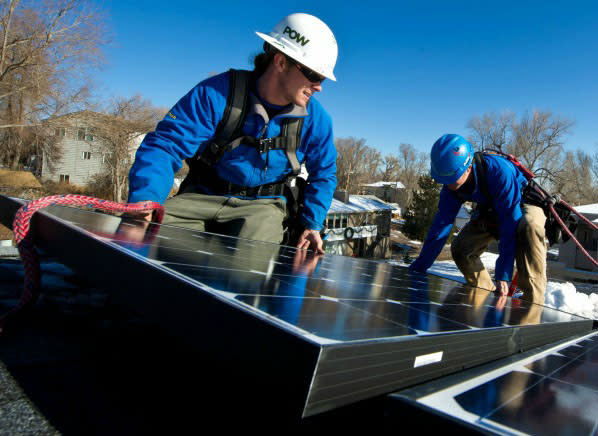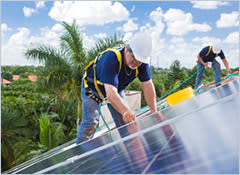Solar power is one way to meet Obama’s energy-saving challenge

President Obama’s Clean Power Plan, a historic step in the fight against climate change and global warming, aims to cut carbon pollution from power plants by 32 percent by the year 2030, compared with 2005 levels. The president compared this reduction to removing 166 million cars from the road.
While this effort is focused on power plants, many consumers want to reduce their reliance on dirty energy. In addition to being green, solar panels—also called photovoltaic (PV) cells—can reduce your monthly electric bills by 50 percent. No wonder rooftop solar capacity nearly doubled from the beginning of 2013 to the end of 2014, according to the U.S. Energy Information Administration—though solar still provides only a small percent of residential power. But going solar isn’t a slam dunk for everyone. Is it right for you? Consumer Reports answers some common questions to get you started thinking.
Does my house have to be situated in a very sunny spot?
A. The more sunshine you have, the more power your system can produce. But the amount you can save on your bills also depends on the price you pay for electricity and the available credits and other incentives from the federal, state, and local government. Most panels are placed facing south, where they get the most exposure. Ideally, your solar panels shouldn’t be shaded by chimneys, trees, or anything else on the rooftop. That includes trees that could grow tall enough to shade the rooftop panels.
About how much power can I expect to get?
A. Most systems can provide 25 to 100 percent of a homeowner’s electricity needs. Solar installers will be able to collect information about the amount of electricity you use, how much you pay for it, and what you’ll save if you opt for different size systems.
Is it possible to save up power to use at night or on rainy, overcast, days—or during a power outage?
A. Disconnecting from the grid isn’t really practical yet. Though they are fairly pricey right now, you can have batteries installed along with the solar panels that allow you to store power generated during the day for use at night or at a later date. Tesla got a lot of attention when the company announced its Powerwall rechargeable lithium-ion batteries earlier this year. They start shipping in the months ahead and will cost $3,000 to $3,500 before installation. Other companies are introducing similar products, including Daimler AG with its Mercedes-Benz energy-storage units that also use lithium-ion batteries.
My area is prone to storms. Can hail and lightning damage solar panels?
A. Better-quality solar panels have impact-resistant, tempered glass that can take a beating without damage. But that doesn’t mean you’ll have warranty coverage if a hailstone ruins a panel. So, amend your homeowner’s insurance so that the cost to repair or replace solar equipment is covered for fire, impact, and other damage. And make sure that the cost to repair or replace your system doesn’t exceed the current coverage limits on your policy.
Will solar panels damage my roof?
A. Properly installed panels should not cause any damage to your roof. In fact, the panels tend to protect the roofing materials they cover by shielding them from precipitation, light, and heat.
That said, a roof’s working life can range anywhere from 15 to 30 years, and a PV system’s service life can be upwards of 25 years. So install the PV system on a roof with at least as long an expected life as that of the solar components. If you have sufficient land, you can have a ground-mount system installed out of view of the house. (Such systems usually cost a bit more to install since wires need to be buried.)
What the Clean Power Plan means for consumers
For more information, read “The Clean Power Plan Is Here: What It Means for Consumers,” by Shannon Baker-Branstetter, Policy Counsel, Energy and Environment for Consumers Union the policu and advoacacy arm of Consumer Reports. “This plan could change the future of our electricity in the U.S. for the better, if it prevails against expected legal and legislative challenges backed by industry groups.”

Aren’t solar systems crazy expensive?
A. Buying a system outright will likely save you the most money over time, but requires a large upfront investment. The typical installation runs about $15,000 to $21,000 in the U.S., according to the Solar Energy Industries Association.
If you install a system before December 31, 2016, you’re eligible for a 30 percent Federal tax credit on the amount you spend. So if you spend $18,000, your tax credit will be $5,400. Some states and local governments provide additional incentives. State-by-state discounts are available at Dsireusa.org. And ask your municipal office if there are any local perks. If your home is assessed at a higher value based on your installation, you may be able to dodge a property tax increase, for example.
Solar panels are usually warranted to last 20 to 25 years, and the systems often pay for themselves after 5 to 10 years, so you have the potential for free electricity for the rest of their lifetime.
I can’t afford to purchase a system. Is leasing cheaper?
A. Initially, yes, but you’ll likely pay more over the life of a 20-year contract than if you buy. Though solar is available in all 50 states, leasing firms don’t operate in all areas. You can often have a system installed for free, and repay the company through a monthly fee. Leasing contracts usually include an “escalation schedule” that specifies how much your payments will go up over time. So, be aware that your fee might not be fixed over the lifetime of the lease, but that should be clearly spelled out in the contract. Note that the leasing company keeps all the tax credits and discounts. Make sure your contract spells out who is responsible for maintenance and for repairs to the system and to your roof. Usually it’s the leasing company, not you, that's responsible for repairs to the solar system because it is the owner.
You can compare leasing and buying deals for free at Energysage.com. The site, which is paid a fee by the solar companies if you buy or sign up for a leasing deal through them, will obtain quotes on your behalf from several vendors. Energysage requires them to standardize comparison data so you get “apples to apples” quotes.
After you decide if buying or leasing is right for you, solicit quotes from several contractors on your own, to be sure you’ve found the best deal. Get at least three references from your top choices and contact those customers to find out if they were satisfied with the work that was done, and ask if the project came in on budget and on schedule.
What happens if I sign a lease, then want to sell my house before the lease is up?
A. If you need to terminate your lease because you are selling your house, you may be able to transfer the remaining lease to the buyer or buy the PV system from your leasing company and include it in the sale of your property.
What about maintenance?
A. With few or no moving parts, panels usually need little attention. The one exception is the inverter that changes direct current (DC) to alternating current (AC). The inverter should last for about 15 years, replacing it can cost $1,000 to $1,500, which is typically about 10 percent of the cost of a rooftop solar system.
What should I look for in a PV installer?
A. The North American Board of Certified Energy Practitioners and the Solar Energy Industries Association both maintain state-by-state lists of contractors and solar installers. Beyond that, an installer should have general liability and workman’s compensation insurance, along with a contractor’s license for the region in which you live. Find out if the installer will obtain all the necessary permits. If the installer will use a subcontractor to do the work, verify that they are properly certified, insured, and licensed as well.
Ideally, a structural engineer as well as a roofer should assess the roof’s condition as well as how much weight it can handle. That includes both the panels, racking, and the potential weight of any snow that might normally fall on the roof. Before installing a rootop solar system, contact the manufacturer of your roofing and ask for written approval of the solar installation to make sure that the roofing warranty will not be voided. (For roofer referrals, visit the National Roofing Contractors Association).
—Consumer Reports
More from Consumer Reports:
The best energy efficient air conditioners
5 terrific side by side refrigerators
Best places to buy large and small appliances
Consumer Reports has no relationship with any advertisers on this website. Copyright © 2006-2015 Consumers Union of U.S.


